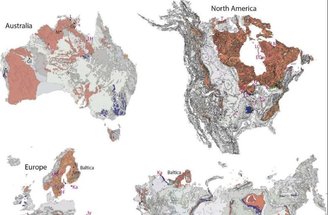Apparently, Saturn isn't the only planet in the Solar System to have rings made of dust, gas, small rocks, and other space debris — Earth may have had its own 'stripes,' too. According to a new study published in the journal Earth and Planetary Science Letters, The Earth has already formed a ring around itself millions of years ago.
A team of researchers from Monash University in Australia claims to have found evidence that Earth may have exhibited a ring system approximately 466 million years ago. To reach this conclusion, the scientists ran simulations of plate tectonics during the Ordovician period, when Earth was frequently bombarded by meteorites.
In the study, they analyzed 21 asteroid impact craters, all located within 30 degrees of the equator. After colliding with Earth, a large asteroid broke up and its debris formed a huge ring around the planet.
Additionally, researchers believe that this phenomenon may have blocked some sunlight during the Ordovician. This may have contributed to one of the coldest periods on Earth in the last 500 million years.
“Over millions of years, material from this ring gradually fell to Earth, creating the peak of meteorite impacts observed in the geological record. We also see that layers in sedimentary rocks from this period contain extraordinary amounts of meteorite debris,” said lead author Andy Tomkins, a professor in Monash University's School of Earth, Atmosphere and Environment.
Earth with a ring system
If scientists are correct, the discovery of a ring system on Earth would completely change our understanding of one of the coldest periods the planet has ever seen, at the end of the Ordovician. The discovery also suggests that space events may have had more influence on Earth than we previously thought. — after all, if that happened, the planet's temperatures were profoundly affected.
 The map shows the areas that were close to the Earth's equator during the Ordovician.Source: Earth and Planetary Science Letters
The map shows the areas that were close to the Earth's equator during the Ordovician.Source: Earth and Planetary Science Letters
In any case, it is important to note that scientists still need to study the subject in depth to understand whether Earth really did have a ring system in the very distant past. If this did indeed occur, the team suggests that other similar events may have occurred in Earth's past and influenced the planet's climate.
“Given the longevity of the impact peak and the accumulation of sediment-hosted L-chondrite debris, we suggest that a debris ring formed after this rupture event, from which material deorbited to produce the observed crater distribution. We further speculate that the shading of the Earth by this ring may have triggered the cooling in the Hirnantian 'icehouse' period.”the study concludes.
Have you ever imagined what planet Earth would be like if it had rings like Saturn? Tell us on our social media and share the article with your friends. See you next time!